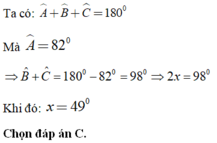

Hãy nhập câu hỏi của bạn vào đây, nếu là tài khoản VIP, bạn sẽ được ưu tiên trả lời.



\(a,x^2-113=31\\ \Leftrightarrow x^2=144\\ \Leftrightarrow x=\pm12\\ Vay...\\ b,\sqrt{x+2,29}=2.3\\ \Leftrightarrow x+2,29=6^2\\ x=36-2,29=33,71\\ c,x^4=256\\ \Leftrightarrow x=\pm4\\ Vay...\\ d,\left(\sqrt{x}-1\right)^2=0,5625\\ \Leftrightarrow\sqrt{x}-1\in\left\{-0,75;0,75\right\}\\ \Leftrightarrow\sqrt{x}\in\left\{0,25;1,75\right\}\\ Vay...\\ e,2\sqrt{x}-x=0\\ \Leftrightarrow\sqrt{x}\left(2-\sqrt{x}\right)=0\\ \Leftrightarrow\sqrt{x}=0hoac2-\sqrt{x}=0\\ \Leftrightarrow x=0hoacx=4\\ f,x+\sqrt{x}=0\\ \Leftrightarrow\sqrt{x}\left(\sqrt{x}+1\right)=0\\ \Leftrightarrow x=0hoacx=1\)
a. x2−113=31
=> x2=144
=> x2=\(\sqrt{144}\)
=> x=\(\pm12\)
c.x4=256
=> x4=44
=> x=\(\pm4\)

đây là cậu chép trg chỗ giải đáp rồi mà mk ko đc lm giống trg giải đáp

1.
\(\left(x-40\right)^2+\left(y+50\right)^2=0\\ \Rightarrow\left\{{}\begin{matrix}x-40=0\\y+50=0\end{matrix}\right.\Rightarrow\left\{{}\begin{matrix}x=40\\y=-50\end{matrix}\right.\)
vậy cặp số (x;y)=(40;-50)
\(\left(x-40\right)^2+\left(y+50\right)^2=0\)
\(\left\{{}\begin{matrix}\left(x-40\right)^2\ge0\\\left(y+50\right)^2\ge0\end{matrix}\right.\)
\(\Rightarrow\left(x-40\right)^2+\left(y+50\right)^2\ge0\)
Dấu "=" xảy ra khi:
\(\left\{{}\begin{matrix}\left(x-40\right)^2=0\Rightarrow x-40=0\Rightarrow x=40\\\left(y+50\right)^2=0\Rightarrow x+50=0\Rightarrow x=-50\end{matrix}\right.\)

c, \(\left(7-3x\right)\left(2x+1\right)=0\)
=> \(7-3x=0\) hoặc \(2x+1=0\)
\(3x=7-0\) hoặc \(2x=0-1\)
\(3x=7\) hoặc \(2x=-1\)
\(x=7:3\) hoặc \(x=-1:2\)
\(x=\dfrac{7}{3}\) hoặc \(x=-0,5\)
Vậy, \(x\in\left\{\dfrac{7}{3};-0,5\right\}\)

Vì \(b\ne d;b+d\ne0\) nên áp dụng tính chất cảu dãy tỉ số bằng nhau ta có:
\(\dfrac{a}{b}=\dfrac{c}{d}=\dfrac{a+c}{b+d}=\dfrac{a-c}{b-d}\)
Vậy \(\dfrac{a+c}{b+d}=\dfrac{a-c}{b-d}\) (đpcm)
Chúc bạn học tốt!!!
Ta có:Nếu
\(\dfrac{a+c}{b+d}=\dfrac{a-c}{b-d}\)
thì \((a+c)(b-d)=(a-c)(b+d)\)
\(a(b-d)+c(b-d)=a(b+d)-c(b+d)\)
\(ab-ad+bc-cd=ab+ad-bc+cd\)
\(=\)\(ab-ab\)\(-ad+ad\)\(+bc-bc\)\(-cd+cd\)
\(=0\)
\(\Leftrightarrow\left(a+c\right)\left(b-d\right)\)\(=\left(a-c\right)\left(b+d\right)\)
\(\Leftrightarrow\dfrac{a+c}{b+d}\)\(=\dfrac{a-c}{b-d}\)

Ta có a // b, nên
góc B = góc A = 90 độ (đồng vị)
Ta lại có \(\widehat{C}+\widehat{D}=180^o\)
hay \(130^o+\widehat{D}=180^o\Rightarrow\widehat{D}=180^o-130^o=50^o\)
vậy góc B = 90 độ
góc C = 50 độ

\(VT=\dfrac{a+c}{a+b}+\dfrac{b+d}{b+c}+\dfrac{c+a}{c+d}+\dfrac{d+b}{d+a}\)
\(=\left(a+c\right)\left(\dfrac{1}{a+b}+\dfrac{1}{c+d}\right)+\left(b+d\right)\left(\dfrac{1}{b+c}+\dfrac{1}{d+a}\right)\)
Ap dụng \(\dfrac{1}{x}+\dfrac{1}{y}\ge\dfrac{4}{x+y} \left(\forall x,y>0\right)\)
Ta có: \(VT\ge\left(a+c\right).\dfrac{4}{a+b+c+d}+\left(b+d\right).\dfrac{4}{a+b+c+d}\)
\(=\dfrac{4\left(a+b+c+d\right)}{\left(a+b+c+d\right)}=4\left(ĐPCM\right)\)